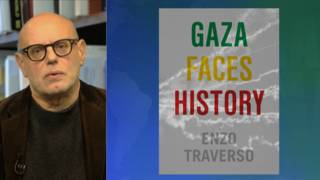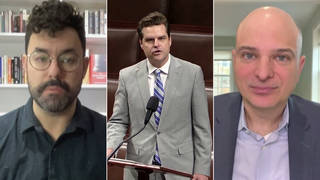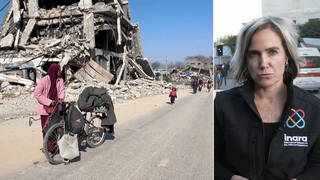
Related
Guests
- Michele Barrydirector of the Center for Innovation in Global Health at Stanford University. She is the incoming chair for the Consortium of Universities for Global Health. Dr. Barry is also the past president of the American Society of Tropical Medicine.
As the worldwide death toll from the coronavirus pandemic has topped 10,000, with over 250,000 confirmed cases of COVID-19, we speak with Stanford University’s global health expert Dr. Michele Barry, an infectious disease doctor. Italy has surpassed China in coronavirus deaths, and cases are rising in the Middle East, Africa and Latin America, as the governor of California has ordered all 40 million residents to shelter in place.
Transcript
AMY GOODMAN: The worldwide death toll from the coronavirus pandemic has topped 10,000, with nearly a quarter of a million confirmed cases of COVID-19. Italy’s death toll has now surpassed China’s, where the outbreak was first reported, with over 3,400 deaths and more than 41,000 confirmed cases. In Iran, the Middle Eastern nation worst hit by coronavirus, the Health Ministry said the death toll has approached 1,300, with one person dying from it every 10 minutes and 50 becoming infected every hour. In Latin America, El Salvador, Nicaragua reported their first confirmed cases of coronavirus. South America has nearly a thousand confirmed infections, as Brazil, Chile and Peru all report hundreds of confirmed cases. Venezuela has announced a nationwide quarantine. In Africa, the number of confirmed cases has risen to 700, and the head of the World Health Organization had said Africa must, quote, “wake up to the coronavirus threat and prepare for the worst.”
In the United States, confirmed coronavirus cases have doubled over the past two days. New York has become the epicenter of the pandemic with more than 5,200 confirmed cases, the highest in the nation. In California, Governor Gavin Newsom on Thursday ordered all 40 million residents to remain at home, to shelter in place, effective immediately.
GOV. GAVIN NEWSOM: The virus will impact about 56% of us. You do the math in the state of California, that’s a particularly large number. That number, in and of itself, shouldn’t be overly alarming. The vast majority of us, the overwhelming majority of us, won’t have symptoms, will be perfectly fine.
AMY GOODMAN: With over 22 million people facing infection in California over the next eight weeks, Governor Newsom estimated the state’s hospital capacity has 20,000 fewer beds than will be needed at the peak of the pandemic.
For more, we go to California, where we’re joined by Dr. Michele Barry, director of the Center for Innovation in Global Health at Stanford University, incoming chair for the Consortium of Universities for Global Health. Dr. Barry is also the past president of the American Society of Tropical Medicine. She’s joining us from her home, as California is under a shelter-in-place order.
Dr. Barry, thank you so much for joining us. Before we start on the global picture, if you could just simply explain — people say “coronavirus,” people say ”COVID-19.” Explain where that term ”COVID-19” came from, what it means, and then the class of coronaviruses, what that means, as well.
DR. MICHELE BARRY: Well, good morning, and thank you. The name “coronavirus” comes from a series of viruses that are found in bats. There are about 1,300 species of bats. And at any one time, there are about six to eight coronaviruses that are circulating in bats. So, there are many different species of bats. There are only seven species that have been known to infect man so far, four of which we all know very well. They cause the common cold, and there are three that are more deadly: SARS1, SARS2 and MERS. The term “corona” comes from the halo that is seen around the virus, with the spikes that come out of the coronavirus when you look at it under electron microscopy.
AMY GOODMAN: And ”COVID-19” means?
DR. MICHELE BARRY: It’s a term that actually most people are — it’s a coronavirus disease, and it happened in the year '19. Some people use the word “novel” in front of it, but it is synonymous for what is called SARS2, severe acute respiratory syndrome. And it's the second such coronavirus that we’ve seen that causes severe acute respiratory disease.
AMY GOODMAN: So, let’s talk about where this pandemic is hitting hardest. In our headlines, we just talked about Italy surpassing China. Why don’t you take us, really, on a tour of the world. How has this happened? Why is Italy the epicenter, Europe itself the epicenter, and also Iran so hard hit at this point? How did this all unfold?
DR. MICHELE BARRY: Well, it’s an interesting story. And I’m going to step back and take a larger picture about it, because I’m very interested in one health and climate and planetary health. And I know we’re all obsessed about this virus, but I think we have to think about what some of the activities that have happened in this Anthropocene, where men have impacted the planet. We have changed the ecology of how we live with animals, so that if you look at most of the emerging viruses and the emerging diseases that have happened over the last hundred years, they’ve been what we call zoonoses. And zoonoses are spillover from animals.
This particular coronavirus was noted first in a seafood market in Hunan, and it has to do with the fact that there probably — even though this is a bat coronavirus, we do not know whether there’s an amplifier animal in SARS1, which also started in a seafood market in an area in China. It’s the intimate living with humans and animals and spillover. In SARS 1, it was probably a civet cat that was being sold. For a while, SARS2, this particular virus, was thought to be an amplifier with a pangolin, a highly trafficked animal. We know now that that’s probably not true, and we don’t know exactly how it actually began in the seafood market.
But I want to bring us back to this idea that we need to be doing better surveillance in our animals and doing a better job with our planet. The large Nipah virus epidemic had a lot to do with deforestation and movement of bats closer to other animals, and another novel virus emerged. So I want to bring people back to some of the larger issues, when we think about these emerging viruses that happen in the world.
AMY GOODMAN: And a connection to climate change, to the climate crisis?
DR. MICHELE BARRY: Yeah. Well, that is important. Climate change, deforestation and changing ecology is crucial for how we have animal and human ecology change. For instance, we saw the Zika outbreak happen several years ago in northeast Brazil. There’s been a lot of interesting discussion how deforestation may have played a role in that, and higher temperatures may have played a role in changing vectors, mosquito vectors in that role. Mosquitoes play no role in SARS, don’t worry. But it’s a very important question that I think, when this all quiets down — we’re sort of in the thick of this epidemic — I think we need to pay more attention to this concept of what I’m calling human and planetary health. We’re actually trying to build a new center for human and planetary health at Stanford. We’re working on a new postdoctoral fellowship for scientists to actually study this human ecology change.
AMY GOODMAN: We’re going to break, and then we want you to take us from Italy to China to Iran. We want to look at Africa, which you’ve called a “ticking time bomb,” and Latin America, Asia. Dr. Michele Barry, director of the Center for Innovation in Global Health at Stanford University, she’s an infectious disease doctor. Stay with us.
[break]
AMY GOODMAN: That’s quarantined Italian tenor Maurizio Marchini, passionately singing “Nessun dorma,” or “None Shall Sleep,” from his balcony in Florence, Italy, while the country is under lockdown from the coronavirus. This is Democracy Now!, democracynow.org, The War and Peace Report. I’m Amy Goodman. The worldwide death toll from the coronavirus pandemic has topped 10,000, with nearly a quarter of a million confirmed cases of COVID-19. Our guest is Dr. Michele Barry, Center for Innovation in Global Health at Stanford University. She’s an infectious disease doctor herself.
So, take us on a tour, but begin with — we just played this magnificent music of a quarantined opera singer singing out to his community. “Quarantine,” what does that word mean, Dr. Barry?
DR. MICHELE BARRY: So, that’s an interesting — I think there’s a lot of different understanding of what isolation and quarantine is. The word “quarantine” actually is an Italian word that comes from the word ”quaranta,” or “40” days. And those were the amount of days that a ship actually had to stay in port before being released into Venice when the Black Plague was occurring. So it actually comes from that word during the Black Death. When we think about quarantine and the difference between quarantine and isolation, isolation is when one has a sick person, and you isolate them, whereas quarantine is if you’ve had contact with a person, you need to stay at home and minimize contact, with family — well, with other people, other than your family, for 14 days.
AMY GOODMAN: So, let’s talk about Italy. Why is it the epicenter right now? Why has Italy become the epicenter? It surpassed China, and it has a link to China.
DR. MICHELE BARRY: I’m sorry? I didn’t —
AMY GOODMAN: It surpassed China, and it has a link to China. What is the connection? Why has it been hit so hard? And then, compare it to South Korea.
DR. MICHELE BARRY: Yeah. I think what South Korea — I can’t comment upon why Italy has been hit so hard. We can only speculate. And I don’t want to say anything, because I have a lot of Italian colleagues that are working incredibly hard to stave this epidemic. Most of us feel that they got behind the curve. And behind the curve is of — we really have no vaccine or effective treatment yet for this virus. What we do have is what we call nonpharmaceutical interventions. And that is basically quarantine and isolation and good transparent communication and testing, testing and surveillance.
And I think what South Korea and what Taiwan and what Singapore did that have made such a huge difference is that they did early testing, early surveillance. They quarantined people who had contacts, and isolated those that were sick. It’s clear, when you look at the Chinese numbers, and what Wuhan did was pretty amazing. They did very aggressive isolation and quarantine, whereas the Italians — and one can say it has to do with measures that are taken in not only a governmental — and you can argue about whether the Chinese were draconian, but they were very effective. You can talk about different kinds of cultures, how accepted it is to isolate yourself and wear masks. But whatever it was, Italy started behind the curve.
I think we, in California, we’re trying to be as aggressive as we can. We’re very early, particularly in my county, which was an early epicenter, Santa Clara County. And I have to give kudos to Sara Cody, who is our public health commissioner. She did early shelter in home. So I think these nonpharmaceutical interventions are really important.
And then — and this is more up your show — I think we need very strong central coordination. If you read a paper written by Jason Wang in JAMA, where he describes the early Taiwan approach, it was because there was strong central coordination. They had the ministers of labor, the ministers of education, the ministers of transportation all working together to give daily communication, and not misinformation, out there.
AMY GOODMAN: And is there a connection between particularly northern Italy and China, population movements, I mean, also, the whole supply chain, companies that are in China but serving populations in Italy, the United States, etc.?
DR. MICHELE BARRY: The amount of manpower that went into stopping the transmission in China was amazing. They sent 40,000 doctors to the Wuhan area. They had thousands of epidemiologists, so that teams of epidemiologists, with five to a team, would actually do contract tracing for one person. I don’t think Italy has that manpower. And we certainly know that they don’t have the manpower now with their doctors or nurses.
And many of us in the U.S. are very worried about overwhelming our hospital systems. I think you’ve heard a lot of discussion recently about flattening the curve. And what does that mean, flattening the curve? It doesn’t mean necessarily curing the disease. What it does is help not overwhelm our hospital system, which is what we’re all worried about. Already we’re worried about having enough nasopharyngeal swabs to do testing. I mean, we are way behind in our testing. If you look at South Korea, they did 5,000 tests per million people. We’re not even up to a hundred testing per million people.
AMY GOODMAN: How did that happen, Dr. Barry? How did this happen? The U.S. is supposed to be the leader in the world. Was this a combination of President Trump’s anti-science approach and his nationalist approach, xenophobic approach? I mean, didn’t the World Health Organization have a test that all of these countries have used, that the U.S. rejected, the CDC then put out its own, and it was flawed?
DR. MICHELE BARRY: I can’t comment on that, because I wasn’t involved in that decision. But certainly, it is really a travesty that we don’t have enough tests and that we’re not testing aggressively. It did not help to have a president that doesn’t believe in science — actually, early on, called this all a hoax. It really helps when a president believes in science and evidence-based science. So, yes, that is disturbing. But I can’t comment on what the machinations were. Our CDC is working very hard. Many of my colleagues are working around the clock trying to stave this off.
But one of the things about epidemics is it’s really important to have what I call shared global governance. And I don’t think in this world it’s great that we don’t have a stronger central governance of our world health. We have a World Health Organization that has a budget that is less than many of our hospitals in the United States. Even in the United States here, our par excellence group, the CDC, the Center for Disease Control, is not allowed to come into a state unless it’s invited by the state. We have a legacy of federalism, where the states are really the forefront of public health. And even within the state of California, our county has different recommendations than the next county over. So each of our counties are making decisions.
I think what is so amazingly powerful by some of the countries that have been able to contain this, like Singapore, Taiwan and China, has been central coordination. You may argue that some have been very draconian, but then, when you have a small little country like Taiwan, that abuts China and was able to do it with central command — and I actually visited the central command station in Taiwan about two years ago. It’s very impressive. They set that up.
Now, admittedly, those countries that have done very well, Amy — and people haven’t talked about this — they have had the experience of SARS1, so they were set up. For instance, there were fever clinics set up, where if people had fever, they were immediately transferred to these clinics. They had ability to build hospitals rapidly, which we have not had that ability. They were able to isolate sick people and not put them necessarily back into family units. If you look at the China data, most of the transmission drive was in family clusters, wasn’t necessarily in nursing homes or schools, which is where we usually think the drive for these clusters are. Actually, the majority of the clustering of illnesses were in the family. So isolating sick people becomes very key.
And we have a problem in this country with our homeless. I was talking to our county official, our public health official, and she is really working endlessly to try to buy up hotels, buy RVs, try to figure out how to isolate our homeless population.
AMY GOODMAN: To not get COVID-19.
DR. MICHELE BARRY: Yes, yes.
AMY GOODMAN: So, what happened in Iran?
DR. MICHELE BARRY: Oh, Iran. Iran was the perfect storm of — and let’s talk a little bit about that also, but it was the perfect storm of religion and politics and public health. And this had to do with the fact — because it’s kind of an interesting — why would you think Iran — and I don’t know — I have a slide with the curves, if that could come up, of how fast that curve went up. And you might wonder why it is that Iran sort of exploded. Well, it had to do with the fact that they have a very holy shrine in the town of Qom. And what happened, according to my Iranian colleagues that I’ve been talking to, is that there was a group of 700 Chinese pilgrims that were there from the Hubei province. And part of how one gives homage to this shrine is by kissing it or licking it. So you can imagine how that was a very easy way to immediately disseminate it. My understanding from my Iranian colleagues also, it’s been very hard to actually even barricade this shrine off currently, even in the midst of this epidemic. And we’ve seen how religion has also played a role in South Korea. The earliest cluster was in a church, where you have large gatherings of people. And even in New York City — and please correct me, but I’ve been following your epidemic, as well — that there’s been a real problem in the early Orthodox Jewish population, where that outbreak in the Hasidic population has occurred.
AMY GOODMAN: So —
DR. MICHELE BARRY: Yeah.
AMY GOODMAN: Right now it’s just exploding in Iran. And then I want you to talk about Africa, which you’ve called a “ticking time bomb.”
DR. MICHELE BARRY: Yeah. I think there are two ticking time bombs that I’m worried about — not only Africa, but India, because we haven’t heard a lot about India, and that’s, you know, over a billion people that are a very closely geographic space.
But the time bomb in Africa is really about healthcare capacity. I spent a lot of time working in sub-Saharan Africa, and we’re all extremely worried about it. We’re starting to see it take off in South Africa. The issue about why it’s a ticking bomb is, again, it has to do with surveillance and the lack of ability to test. The last numbers — and I may be a little outdated, because [inaudible] — we’re all — it’s like a firehose. We’re all watching these numbers. But the last numbers I looked at were that there were only 40 out of 54 countries that were able to do testing for COVID-19 or SARS —
AMY GOODMAN: And in —
DR. MICHELE BARRY: — SARS2. And —
AMY GOODMAN: Go ahead.
DR. MICHELE BARRY: Amy, this is not the only coronavirus we’re going to see. Unless we pay attention — I’m really going to come down hard on this — on this concept of one health, keeping an eye on the intersection of our animals, our environment and our human health, are we going to get ahead of the ball for epidemics. Because this is not the big one. I mean, we think we’re living in the big one. The big one is really a pandemic flu, which is airborne and not droplet-borne.
AMY GOODMAN: And that — you talk about airborne, not droplet-borne — what does that mean? And is the coronavirus not only an issue of someone coughing or sneezing or getting droplets on another person, but this whole question of what does it mean to be aerosolized?
DR. MICHELE BARRY: So, yes, SARS2 can be aerosolized, if you are doing a procedure which vigorously causes massive aerosolization, like when you intubate somebody. This is why healthcare workers — and there were 4,000 healthcare workers in China that actually got infected. The lovely thing about infecting young people is that there’s a much smaller — even though it’s really important to think about the young people, the mortality rate in young people is much lower. But let’s go back to this question of aerosolizing. So, this has to do with the size of the droplets and how they’re actually suspended in air. The size of the droplets for SARS2, or COVID-19, are larger droplets, and they fall, and they fall way within six feet, which is why we have these six-foot distance that we’re asking people to stay away from, although healthcare workers are at much higher risk when they do aerosolizing procedures. And so we need to be careful about that. In SARS1, actually, one of the earliest disseminations was through fecal dissemination in the early residential building in Hong Kong, where there was a problem in the toilet. And we all know that SARS1 and 2 are —
AMY GOODMAN: And you’re talking about SARS2 is COVID-19?
DR. MICHELE BARRY: COVID-19 is SARS2, I’m sorry.
AMY GOODMAN: Is coronavirus.
DR. MICHELE BARRY: Yeah. See, most of us are using SARS1 and SARS2. But for this purpose, I’ll use COVID-19. COVID-19 is fecally excreted. But there have not been — first of all, diarrhea is not a major manifestation in that. But what I was talking about in the first of epidemic with SARS1, not COVID-19, there was fecal dissemination when there was a toilet that malfunctioned and aerosolized feces. So, yes, there is the potential of aerosolization, but it’s only with unique, unique procedures that that happens.
AMY GOODMAN: So, we have to break, but we’re asking to talk to you at the top of the hour, and then we’re going to post Part 2 online, an incredible tutorial, as we look at what’s happening in the world and also how coronavirus is transmitted, with Dr. Michele Barry, director of the Center for Innovation in Global Health at Stanford University, incoming chair for the Consortium of Universities for Global Health. Dr. Barry is also the past president of the American Society of Tropical Medicine. Go to democracynow.org for Part 2.
When we come back, solidarity not charity. We look at the network of mutual aid groups emerging across the country to protect each other in the face of the coronavirus. Stay with us.











Media Options